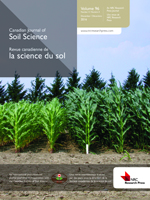Gao, X., Tenuta, M., Nelson, A., Sparling, B., Tomasiewicz, D., Mohr, R. M. and Bizimungu, B. 2013. Effect of nitrogen fertilizer rate on nitrous oxide emission from irrigated potato on a clay loam soil in Manitoba, Canada. Can. J. Soil Sci. 93: 1-11. This study examined the effect of N fertilizer application rate on N2O emissions for irrigated potato production on a clay loam soil near Carberry, Manitoba, over two growing seasons. Treatments were an unfertilized control, and urea-N fertilizer application rates of 80, 160 and 240 kg N ha-1, which were applied as split applications. The marketable yield increased at 80 kg N ha-1 relative to the unfertilized control, but did not respond to higher rates of fertilizer. Peak emission of N2O followed fertilizer application and rain or irrigation events. Emission rates following fertilizer application and water addition events were greater from hill than from furrow position in 2009, but not in 2010. In the latter, ponding of water in furrows likely resulted in the greater emissions than from the hill positions. Cumulative N2O emissions and yield based N2O intensity increased linearly with N application rate. The growing season emission factor (EFgs) for percent of added N emitted as N2O was 0.73% and did not increase with N application rate. The adjusted whole-year emission factor (EFwy) assuming 30% of annual emissions are emitted during winter and thaw was 1.04%, being lower than the Canadian IPCC Tier II protocol value of 1.72% for irrigated cropland in Canada. The lower measured EFwy may be because the protocol assumes that under irrigation water input (rain plus irrigation) equals potential evapotranspiration (PET) from May to October, implying no restriction of N2O emissions by water limitation. For the current study, however, the ratio of water input to PET averaged 70%, suggesting water may have restricted N2O emission, therefore resulting in a lower EFwy than predicted by the Tier II protocol. The results of the current study also suggest that a reduction in N2O emissions can be achieved by avoiding fertilizer N applications beyond optimal for marketable yield, limiting irrigation soon after application of N fertilizer, and managing irrigation to prevent ponding of water in furrows.
How to translate text using browser tools
1 February 2013
Effect of nitrogen fertilizer rate on nitrous oxide emission from irrigated potato on a clay loam soil in Manitoba, Canada
Xiaopeng Gao,
Mario Tenuta,
Alison Nelson,
Brad Sparling,
Dale Tomasiewicz,
Ramona M. Mohr,
Benoit Bizimungu
ACCESS THE FULL ARTICLE
It is not available for individual sale.
This article is only available to subscribers.
It is not available for individual sale.
It is not available for individual sale.

Canadian Journal of Soil Science
Vol. 93 • No. 1
March 2013
Vol. 93 • No. 1
March 2013
Canadian prairies
clay loam soil
coefficient d'émissions
emission factor
humidité
Irrigation
Irrigation




